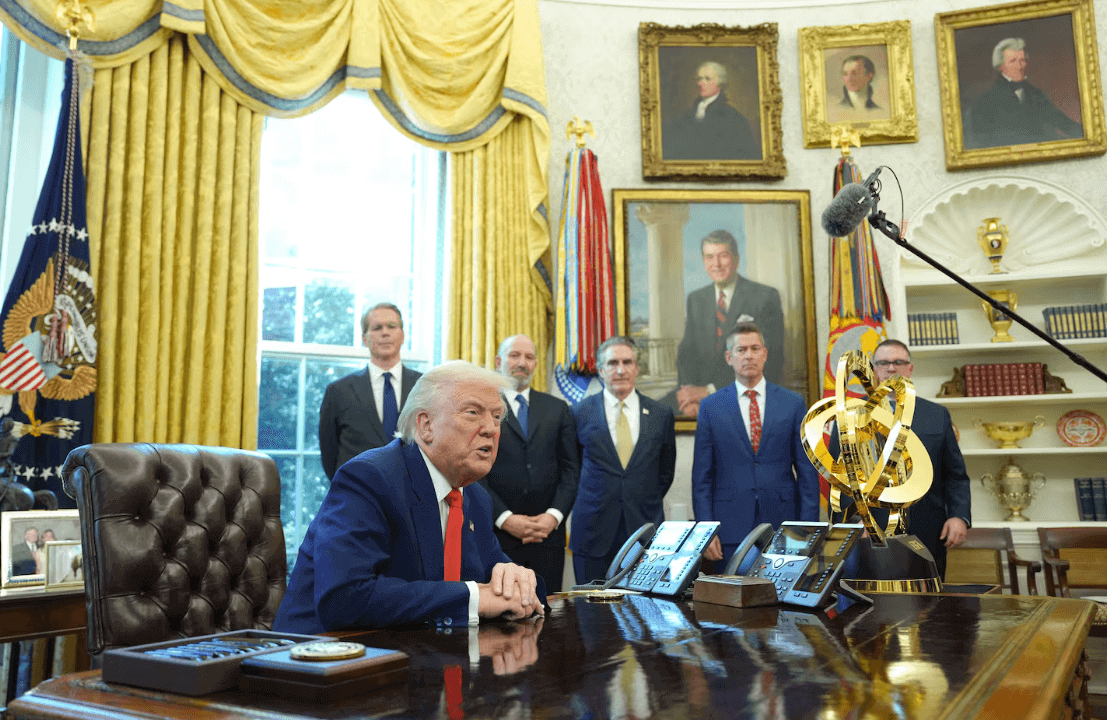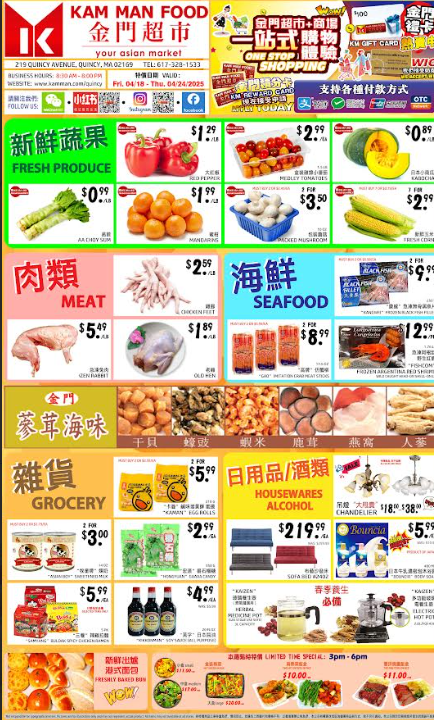特朗普暂停对大多数国家加征关税,同时对中国加征关税

【中美创新时报2025 年 4 月 9 日编译讯】(记者温友平编译)特朗普总统几乎与美国所有贸易伙伴发动了关税战。他断断续续加征新关税的惯常做法仍在延续,周三,在新一轮进口关税生效数小时后,大多数受其影响的国家暂停加征90天。然而,中国是个例外。特朗普在社交媒体上表示,他将“立即”将对华进口税提高至125%,这将进一步加剧两国之间针锋相对的关税。美联社记者怀亚特·格兰瑟姆-菲利普斯美联社对此作了下述报道。
特朗普总统几乎与美国所有贸易伙伴发动了关税战。他断断续续加征新关税的惯常做法仍在延续,周三,在新一轮进口关税生效数小时后,大多数受其影响的国家暂停加征90天。
午夜刚过,数十个国家开始面临美国加征的更高关税,这是特朗普对外国商品全面征收(并自称是“互惠”)关税的一部分。但到了周三下午,特朗普政府突然宣布将暂停加征关税90天,并维持最近对几乎所有全球进口产品征收的10%的关税。
然而,中国是个例外。特朗普在社交媒体上表示,他将“立即”将对华进口税提高至125%,这将进一步加剧两国之间针锋相对的关税。
由于关税行动和威胁来来回回,很难追踪事态发展。此外,还有许多其他进口税仍在实施。以下是您需要了解的信息概要。
特朗普的关税引发了全球贸易战。以下是事态发展的时间线。
哪些关税于周三生效,现在却被推迟了?
在宣布暂停 90 天之前,特朗普最新一轮也是最全面的一轮关税上调已于周三凌晨生效。
特朗普于4月2日宣布了这些新的进口税,他称之为“解放日”,这是一项全面“互惠”贸易计划的一部分。特朗普声称其他国家多年来一直“欺骗”美国,并宣布美国将对几乎所有贸易伙伴征收至少10%的进口税,并对数十个他所说的对美国有贸易顺差的国家征收个别的、更高的进口税。
10%的基准税率已于周六生效,并将在未来对大多数贸易伙伴继续实施。周三的90天暂停期意味着,此前高达50%的更高税率将被推迟。
特朗普政府已表示将利用这段时间与各国进行谈判。周三下午,特朗普在“真相社交”(Truth Social)网站上发帖称,他宣布暂停谈判是因为“超过75个国家”已与美国政府接触进行贸易谈判,但并未采取任何实质性的反制措施。
与此同时,针对中国的更严厉关税措施仍在周三生效。特朗普此前威胁称,将在美东时间凌晨 12:01 将对华关税总额提高至 104%,但周三下午他又表示将把这一数字提高至 125%。
特朗普在“真相社交”上写道:“中国将会意识到,剥削美国和其他国家的日子已经不可持续,也不可接受。”
经济学家警告称,这些关税将推高消费者日常购买商品的价格,尤其是在这些新关税建立在先前贸易措施之上的情况下,而这些措施此前已导致市场陷入混乱。即使对于那些目前有资格暂停征收特朗普更高“互惠”税率的国家来说,10%的关税仍然比美国政府此前征收的关税高出一筹。
还会有更多关税出台吗?
是的。中国已经宣布从周四开始对美国商品征收84%的关税。
上周,中国宣布了一系列反制措施,以应对“解放日”关税,包括计划对美国商品征收34%的关税,以匹配特朗普当时的“对等”税率。但在特朗普威胁——并最终在周三凌晨——将额外加征50%的关税后,中国表示将把关税提高到84%。
中国商务部在发布对美贸易白皮书时表示:“如果美方执意进一步升级经贸限制措施,中方有坚定的意志和充足的手段采取必要反制措施,坚决予以坚决反制,坚决斗争到底。”
中国是否会进一步提高关税还有待观察。在特朗普将美国对中国商品的关税提高至125%之前,中国就宣布了84%的关税。
中美贸易战由来已久。近几个月来,两国互征了一系列针锋相对的关税——除了特朗普第一任期内征收的关税之外,其中许多关税在前总统乔·拜登执政期间被保留或增加。
虽然中国迄今为止采取了最强硬的手段,但许多国家正在评估对特朗普征税的回应——有些国家甚至承诺,即使还没有采取更多报复措施。
周三早些时候,欧盟成员国投票批准对价值230亿美元的美国商品征收报复性关税,以回应特朗普此前对进口钢铁和铝征收的25%关税。欧盟的反制关税将分阶段实施,部分措施将于4月15日生效,其他措施将于5月15日和12月1日生效。欧盟执委会尚未立即具体说明哪些商品将受到影响。
欧盟27国成员国重申,他们倾向于通过谈判达成协议来解决贸易问题,并称美国的关税“不合理且具有破坏性”。在特朗普暂停提高“互惠”关税税率之前,欧盟执行委员会主席乌尔苏拉·冯德莱恩曾提出对工业品实行零对零关税。
特朗普未来还可能推出更多针对特定产品的关税。此前,特朗普曾威胁要对铜、木材和药品等商品征收进口税,而这些商品目前都不受特朗普“互惠”征税的影响。
特朗普在周二晚间的讲话中夸口自己正在发布“突发新闻”,然后又发誓说:“我们将很快宣布对药品征收高额关税。” 在同一讲话中,总统还哀叹美国不再生产其公民所需的许多药品,并表示新的关税将改变这种状况——将药品生产带回美国。
这里还有哪些其他进口税?
一些关税已经生效——包括特朗普于周六生效的 10% 基准税。
在此次大规模征税之前,特朗普已针对特定国家和产品推出了多轮关税。他于上周四开始对汽车进口征收25%的关税,其中对整车进口也征收关税。这些关税预计将在未来几周内(截至5月3日)扩大到适用的汽车零部件。
作为回应,加拿大将于周三对不符合 2020 年美墨加协议的美国汽车进口产品征收 25% 的关税。
特朗普扩大钢铁和铝关税的措施已于上个月生效。目前,这两种金属的关税均已达到25%。特朗普下令取消钢铁关税豁免,并提高铝关税,该措施已于3月12日生效,此前该措施已于2018年实施。
除了此前对中国加征的关税外,特朗普今年早些时候还瞄准了墨西哥和加拿大。由于上周加征的关税,这两个国家免受特朗普的影响,特朗普对这两个国家商品加征了25%的关税,随后又部分暂停了加征。
与此同时,白宫表示,符合USMCA协议的商品可以继续免税进入美国。其他进口商品仍按25%的税率征税,钾肥和加拿大能源产品则按10%的较低税率征税。
白宫表示,一旦两国满足特朗普在移民和毒品贩运方面的要求,对不符合 USMCA 规定的进口产品的关税将从 25% 降至 12%。
美联社驻华盛顿记者乔希·博克 (Josh Boak)、驻曼谷记者吴慧忠 (Huizhong Wu) 和驻布鲁塞尔记者洛恩·库克 (Lorne Cook) 对本报道亦有贡献。
题图:4月9日,特朗普总统在白宫椭圆形办公室签署行政命令时发表讲话。特朗普周三宣布,暂停对大多数国家实施为期90天的“互惠”关税,放弃一项导致市场陷入混乱并威胁全球贸易的政策。埃里克·李/纽约时报
附原英文报道:
Trump pauses steeper tariffs for most countries, while hiking levies on China. Here’s what we know.
By WYATTE GRANTHAM-PHILIPS The Associated Press,Updated April 9, 2025
President Trump speaks as he signs executive orders in the Oval Office of the White House on April 9. Trump on Wednesday announced a 90-day pause on his “reciprocal” tariffs for most countries, backing down on a policy that had sent markets into a tailspin and threatened to upend global trade. ERIC LEE/NYT
Follow live updates on the Trump administration.
NEW YORK (AP) — President Trump has launched tariff wars with almost all of America’s trading partners. And his track record of on-again, off-again new levies continued Wednesday with a 90-day pause for most nations targeted by the latest volley of import taxes, hours after they went into effect.
Just after midnight, dozens of countries began facing steeper duties from the US as part of Trump’s sweeping — and self-described “reciprocal” — tariffs on foreign goods. But by Wednesday afternoon, his administration abruptly said it would suspend these higher rates for 90 days, and instead maintain a recently-imposed 10% levy on nearly all global imports.
China, however, is an exception. Trump said on social media that he would raise import taxes on China to 125% “effective immediately” — escalating tit-for-tat levies that have piled up between the two countries.
With so many back-and-forth tariff actions and threats, it can be tough to keep track of where things stand. And a number of other import taxes are still in place. Here’s a rundown of what you need to know.
Trump’s tariffs have launched global trade wars. Here’s a timeline of how we got here.
What tariffs took effect on Wednesday — and are now delayed?
Before announcing a 90-day pause, higher rates for Trump’s latest — and most sweeping — round of tariffs took effect early Wednesday.
Trump announced these new import taxes on April 2, which he dubbed “Liberation Day,” as part of a sweeping “reciprocal” trade plan. Claiming that others had “ripped off” the US for years, Trump declared that the US would tax nearly all of America’s trading partners at a minimum of 10% and impose individualized, steeper rates for dozens of countries that he said run trade surpluses with the US.
The 10% baseline already went into effect Saturday — and will now stay in place for most trading partners going forward. Wednesday’s 90-day pause means that those steeper levies, which ran as high as 50%, will be delayed.
The Trump administration has signaled that it will use this time to negotiate with individual countries. In a post on Truth Social Wednesday afternoon, Trump said he was declaring the pause because “more than 75 Countries” had reached out to the US government for trade talks and not retaliated in a meaningful way.
Meanwhile, more aggressive tariffs on China still went into effect Wednesday. After following through on a threat to raise levies against China to a combined 104% by 12:01 a.m. ET, Trump said he was upping that figure to 125% Wednesday afternoon.
“China will realize that the days of ripping off the U.S.A., and other Countries, is no longer sustainable or acceptable,” Trump wrote on Truth Social.
Economists warn that the levies will raise prices for goods consumers buy each day, particularly as these new tariffs build on previous trade measures, all of which have already plunged markets into turmoil. And even for countries eligible for the current pause on Trump’s steeper, “reciprocal” rates, 10% still represents an increase in the tariffs previously charged by the US government.
Are more tariffs coming?
Yes. Starting Thursday, China has already said it will tax American goods at 84%.
China announced a flurry of countermeasures in response to the “Liberation Day” tariffs last week, including plans for its own 34% levy on US goods to match what was then Trump’s “reciprocal” rate. But after Trump threatened — and then followed through — on adding an additional 50% early Wednesday, China said it would raise its tariffs to 84%.
“If the U.S. insists on further escalating its economic and trade restrictions, China has the firm will and abundant means to take necessary countermeasures and fight to the end,” the Ministry of Commerce wrote in a statement introducing its white paper on trade with the US.
Whether China will increase its tariffs even further has yet to be seen. The country announced the 84% levy prior to Trump raising the US tax on Chinese goods to a collective 125%.
The trade war between the US and China isn’t new. The two countries have exchanged a series of tit-for-tat levies in recent months — on top of tariffs imposed during Trump’s first term, many of which were preserved or added to under former President Joe Biden.
While China has taken the toughest approach so far, a number of countries are evaluating their own responses to Trump’s levies — and some have promised, if not already taken, more retaliation.
Also earlier Wednesday, EU members voted to approve retaliatory tariffs on $23 billion in goods in response to Trump’s previous 25% tariffs on imported steel and aluminum. The EU’s counter tariffs will come in stages, with some arriving April 15 and others on May 15 and Dec. 1. The executive commission didn’t immediately specify which goods would be effected.
Members of the 27-country bloc repeated their preference for a negotiated deal to settle trade issues — calling the US tariffs “unjustified and damaging.” Prior to Trump pausing his higher “reciprocal” tariff rates, Ursula von der Leyen, head of the EU’s executive commission, had offered a zero-for-zero tariffs deal on industrial goods.
Trump could also roll out more product-specific tariffs down the road. The president has previously threatened import taxes on goods like copper, lumber and pharmaceutical drugs — all of which are currently exempt from Trump’s “reciprocal” levies.
During a speech Tuesday night, Trump boasted he was offering “breaking news” before vowing, “We’re going to be announcing, very shortly, a major tariff on pharmaceuticals.” In the same remarks, the president lamented that the US no longer produces many of the pharmaceuticals its citizens take, and said new tariffs would change that — bringing production of medication back to the US.
What other import taxes are already here?
A handful of tariffs are already in effect — including, again, Trump’s 10% baseline tax which took effect on Saturday.
Prior to that sweeping levy, Trump had rolled out several other rounds of tariffs targeting particular countries and products. His 25% tariffs on auto imports began last Thursday, with taxes on fully-imported cars. Those levies are set to expand to applicable auto parts in coming weeks, through May 3.
Canada responded with a 25% levy on auto imports from the US, effective Wednesday, for products that do not comply with the 2020 US-Mexico Canada Agreement.
Trump’s expanded steel and aluminum tariffs went into effect last month. Both metals are now taxed at 25% across the board, with Trump’s order to remove steel exemptions and raise aluminum’s levy from his previously-imposed 2018 import taxes taking effect March 12.
Beyond previous levies on China, Trump also targeted Mexico and Canada earlier this year. They were spared from last week’s heightened rates, Trump imposed — and later partially suspended — 25% duties on goods from both countries.
Meanwhile, goods complying with the USMCA can continue to enter the US duty-free, according to the White House. Other imports are still levied at 25%, as well as a lower 10% duty on potash and Canadian energy products.
Once the two countries have satisfied Trump’s demands on immigration and drug trafficking, the White House said the tariff on non-USMCA compliant imports will drop from 25% to 12%.
Associated Press Writers Josh Boak in Washington, Huizhong Wu in Bangkok and Lorne Cook in Brussels contributed to this report.

